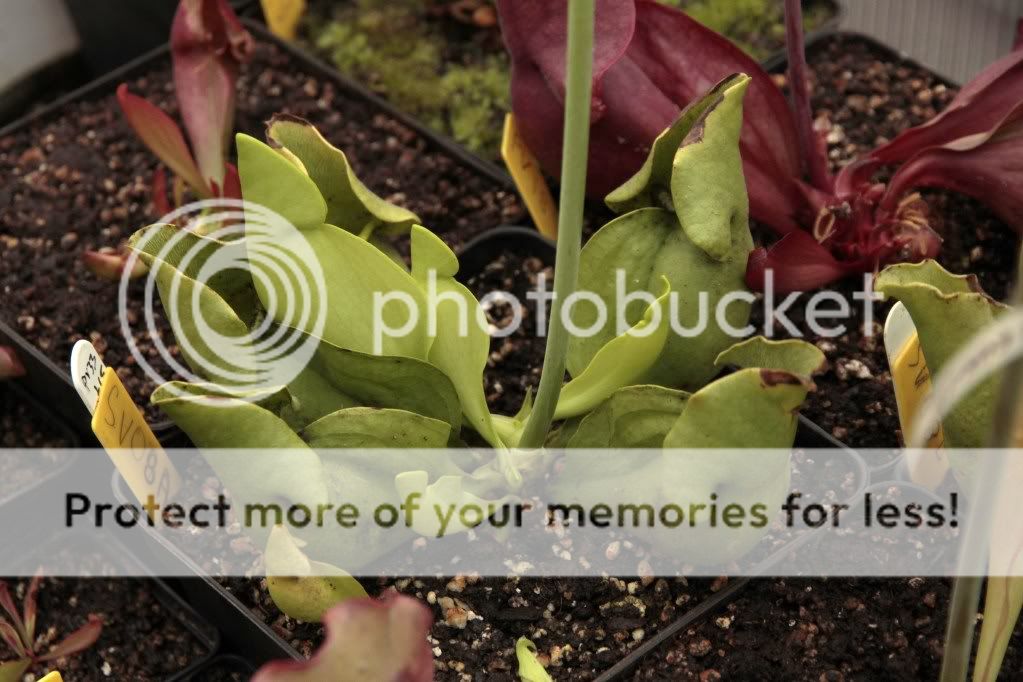|
|
Post by maverick on Apr 8, 2010 22:30:42 GMT
I was very happy when I saw another flower from my anthocyanin free venosas opened all the way. But I was quite surprized to find this little red flush on the sepals. I know it is hard to see, but it defenately is there(at the base of the sepal near the stem). In real life it's a lot clearer than on the picture. The plant defenately looks antho free and is always grown in full sun. Does somebody knows if these antho free plants can make some kind of red coloration that's not anthocyanin?   The plant comes from all those antho free venosas Christian Klein has made, so I don't doubt it it's really antho free. The tissue isn't damaged at all neither, it's still very stiff and absolutely not dead or rotting, though the color suggest that. It's also nothing that has collected in the peatmix and was then absorbed by the plant, because all my other green venosa's are in the exact same mix(repotted at the same time)and grow in the same tray. First I was thinking about some sort of iron oxides, but there isn't any iron in my water collecting system, everything is from plastic. My other anthocyanin free venosa doesn't show me any red or brownish flushes in the sepals, neither does my venosa var. burkii f.luteola flower. If somebody can give me a clear answer I would be very glad. Thanks and happy growing! |
|
|
|
Post by ICPS-bob on Apr 9, 2010 0:18:14 GMT
A clear answer? Surely you jest!
For some reason, your images are not showing at the moment. I am wondering about the original source of this particular plant. Was it a division from a plant that had no color in the sepals? Or, was it from tissue culture? It could be that a color gene was turned on (a TC sport). If all of the other plants are color-free, I would guess that this plant has a slight genetic anomaly. Is this the first year that it flowered? Had you noticed the color in previous years?
|
|
|
|
Post by maverick on Apr 9, 2010 7:05:03 GMT
Hi Bob,
Here the pictures are visible, I don't know why you can't see them.
The plant originally came from Christian Klein and he grew a whole lot of these plants from seed and then disturbed them. This all hapened without TC as far as I know.
I got a spare of it from Mike King, Who has got a seed grown plant from Christian.
It's his PV33, and his list also states, Anthocyanin free.
If this would be a veinless purp. I would be very happy, because the only veinless(but not antho free) purps are the ssp. purpurea and the ssp. venosa var. burkii. And this clearly not is a burkii nor a purpurea ssp. purpurea. But normally these so called veinless plants also show some red when damaged or at the ryzome. This one doenst show that to me.
I will cross it with a flava rugelii, and if there is red coloration all over the place in the offsping you can clearly say it's antho free(because the paterns are there in the venosa, but they can't make the anthocyanins) but if it turnes out like a green catesbaei with a rugelii patch I will label it as veinless in stead of antho free.
Thanks a lot!
|
|
|
|
Post by meadowview on Apr 9, 2010 12:37:21 GMT
Hi Laurens:
Red blushing in floral or vegetative structures of anthocyanin-free plants is possible. A classic case was Don Schnell's anthocyanin free Sarracenia jonesii which sometimes have a slight red hint in some leaf veins. Although all Sarracenia studied to date share the lesion in the same gene which blocks anthocyanin biosynthesis there is occasional "leakage" and anthocyanin may be produced in some plants. We don't know why yet but perhaps enzyme activity is restored due to some factor and a small amount of pigment is produced.
You do not have a veinless form in the picture.
Sincerely,
Phil Sheridan
Meadowview
|
|
|
|
Post by maverick on Apr 9, 2010 14:11:49 GMT
Phil, Thanks a lot for your explination, I never knew this could happen in these plants. I now understand a bit of it. It also came to my mind it could be some other red pigment. Like this: en.wikipedia.org/wiki/Betalain But that only occures on plants from another family. So I don't think that will be my answer. |
|
|
|
Post by purpman on Apr 27, 2010 0:43:03 GMT
A question, does anyone know the history of this plant. It looks like it could be of mountain origin. It seems to have that same "folded lid" look of the montane plants. Phil? Any ideas.
|
|







